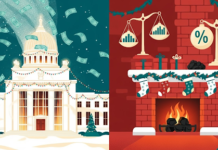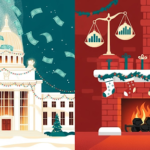Markets Brace for Trump 2.0: Policy Moves and Uncertainty Ahead
Welcome to this week’s edition of The Market Pulse, with Donald Trump officially stepping into his second term as President of the United States, the global markets are watching closely. From proposed tariffs on Mexico and China to deregulation plans that could energize key industries, the markets are already responding.
Over the past week, the Dow Jones rose 3.7%, while the S&P 500 gained 2.9%, signaling cautious optimism. But as we dive into Trump’s ambitious agenda—including rumored corporate tax cuts and regulatory rollbacks—investors face uncertainty. Inflation risks, shifting trade policies, and potential impacts on interest rates will make this week one to watch.
Today’s main feature explores these developments in depth, highlighting the policy areas most likely to shake up the markets. Don’t miss This Week I Learned, where we unpack how tariffs could ripple across the global supply chain. And for a lighter take, check out The Fun Corner for a Wall Street laugh.
Let’s dive into what lies ahead for the markets and your portfolio.
This Week I Learned…
Tariffs: The Domino Effect on Global Supply Chains
This week, I learned how tariffs can ripple through markets in unexpected ways. When a country imposes tariffs on imports, it doesn’t just raise costs for foreign exporters—it increases prices for domestic companies reliant on those imports. For instance, consider auto manufacturers who import parts. A 25% tariff could inflate costs, reducing profit margins or forcing companies to pass expenses onto consumers.
But here’s where it gets complex: Tariffs also create inflationary pressures. As input costs rise, overall production expenses increase, nudging prices higher across the economy. This explains why some economists are concerned about Trump’s rumored tariff hikes. If inflation ticks upward, the Federal Reserve may step in, potentially pushing interest rates higher—a scenario that equity markets typically dislike.
It’s not all bad though. Some companies might shift production domestically or diversify their supply chains to mitigate these risks. For investors, this is a critical moment to evaluate sector exposure, particularly in industries like manufacturing, retail, and technology, which may bear the brunt of trade policy shifts.
In short: Tariffs aren’t just about trade—they’re a global domino game with far-reaching consequences.
The Fun Corner
Investors Walk Into a Tariff…
Here’s a fun fact to break the tension: Did you know that tariffs were originally called “custom duties” in the 18th century, and the U.S. collected most of its revenue from them? Imagine explaining that to today’s fiscal policymakers!
And for a quick laugh:
Why did the investor bring a ladder to the trading floor?
To reach the “new heights” promised after the tariff hike!
Seriously, tariffs are no laughing matter for Wall Street—just ask the financials sector after Trump’s trade proposals last week!
Trump’s Second Term: Markets on Edge as Policy Unfolds
Donald Trump’s second term begins with a full plate of policy initiatives and no shortage of market-moving implications. As Trump prepares to roll out 100 executive orders, investors are paying close attention to three major areas: tariffs, deregulation, and corporate tax cuts.
Tariffs remain one of the biggest uncertainties. With Trump hinting at 25% tariffs on imports from Mexico, Canada, and China, the costs could be steep. A Boston Consulting Group report estimates an additional $640 billion in import costs, affecting industries ranging from automotive to consumer electronics. Inflation concerns loom large, as higher costs could push the Fed toward tightening monetary policy.
Deregulation, meanwhile, has bankers celebrating. Trump’s plan to eliminate ten regulations for every new one passed could free up financial institutions and energy companies, boosting profitability in the process. As Suzanne P. Clark from the U.S. Chamber of Commerce noted, regulatory rollbacks could “set the economy’s animal spirits free.”
Lastly, corporate tax cuts remain a major talking point. Trump is expected to extend the 2017 tax cuts set to expire in 2025. A proposal to lower corporate taxes from 21% to 15% could further stimulate small-cap stocks, which are historically more sensitive to domestic economic growth.
However, policy implementation takes time. While Trump’s initiatives may drive optimism in the short term, the U.S. economy—often likened to a supertanker—requires more than quick shifts to make lasting changes. Investors should expect volatility as markets process each new development.
The Last Say
Uncertainty Is the Only Certainty
As Trump’s second term kicks off, the markets are entering an era of policy-driven volatility. From tariffs to deregulation, the key for investors is to stay alert and informed. Today’s gains in small-cap stocks could evaporate if inflation fears or trade wars escalate, while deregulation and tax cuts could offer longer-term benefits for key sectors.
For now, investors are left waiting. With markets closed on Martin Luther King Jr. Day, this short trading week will likely be shaped by headlines from Washington. Remember, uncertainty is a natural part of market cycles—but it’s also a reminder of the importance of diversification, careful research, and sticking to your investment plan.
Until next week, keep a pulse on the markets!

























